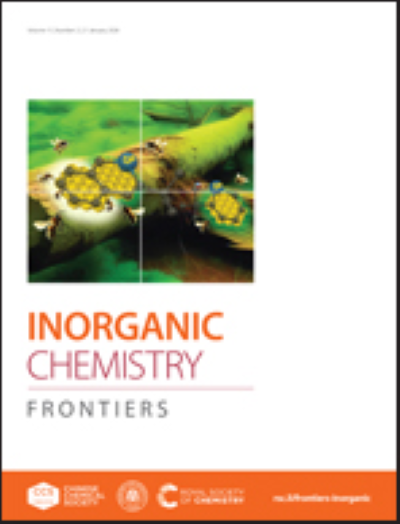Ultra-small β-Ni(OH)2 Quantum Dots Catalyst with Abundant Edges for Efficient Urea Oxidation Reaction
IF 6.1
1区 化学
Q1 CHEMISTRY, INORGANIC & NUCLEAR
引用次数: 0
Abstract
The development of efficient nonprecious-metal catalysts for urea oxidation reaction (UOR) to improve the efficiency of electrocatalytic water splitting for hydrogen production remains a challenge. Herein, we synthesized an ultra-small β-Ni(OH)2 quantum dots catalyst with abundant edges (US-β-Ni(OH)2 QDs) by a coupling approach of co-precipitation and anionic exchange. The obtained US-β-Ni(OH)2 QDs catalyst exhibits high activity toward UOR, and the required potential is only 1.48 V (vs. RHE) to arrive at 151 mA·cm-2. Notably, the US-β-Ni(OH)2 QDs catalyst reflects 4.1 and 96 times higher current density than the β-Ni(OH)2 nanosheets (38.34 mA cm–2) and Pt mesh electrode (1.57 mA cm–2) at the potential of 1.48 V (vs. RHE). The catalytic reaction mechanism indicates that the US-β-Ni(OH)2 QDs catalyst with the ultra-small size (~3 nm) has more abundant edges compared to the β-Ni(OH)2 nanosheets, which provides abundant active sites for catalytic reactions. Moreover, it was found that the Ni-OH bonding of the edge in US-β-Ni(OH)2 QDs is more active than the edge and basic plane of β-Ni(OH)2 nanosheets, which promotes the conversion from Ni2+ to Ni3+ and the adsorption of urea molecules, reducing the energy barrier of UOR reaction and thus improving the UOR performance. This work provides a new approach for synthesizing ultra-small hydroxide quantum dots catalysts with efficient UOR activity but low cost.具有丰富边缘的超小β-Ni(OH)2量子点催化剂用于高效尿素氧化反应
开发用于尿素氧化反应(UOR)的高效非贵金属催化剂以提高电催化水分离制氢的效率仍然是一项挑战。在此,我们采用共沉淀和阴离子交换的耦合方法合成了一种具有丰富边缘的超小型β-Ni(OH)2量子点催化剂(US-β-Ni(OH)2 QDs)。获得的 US-β-Ni(OH)2 QDs 催化剂对 UOR 具有很高的活性,所需的电位仅为 1.48 V(相对于 RHE),即可达到 151 mA-cm-2。值得注意的是,US-β-Ni(OH)2 QDs 催化剂在 1.48 V 电位(相对于 RHE)下的电流密度分别是 β-Ni(OH)2 纳米片(38.34 mA cm-2)和铂网电极(1.57 mA cm-2)的 4.1 倍和 96 倍。催化反应机理表明,与β-Ni(OH)2纳米片相比,超小尺寸(约3 nm)的US-β-Ni(OH)2 QDs催化剂具有更丰富的边缘,这为催化反应提供了丰富的活性位点。此外,研究还发现 US-β-Ni(OH)2 QDs 边缘的 Ni-OH 键比β-Ni(OH)2 纳米片的边缘和基面更活跃,能促进 Ni2+ 向 Ni3+ 的转化和尿素分子的吸附,降低 UOR 反应的能垒,从而提高 UOR 性能。这项工作为合成具有高效 UOR 活性且成本低廉的超小氢氧化物量子点催化剂提供了一种新方法。
本文章由计算机程序翻译,如有差异,请以英文原文为准。
求助全文
约1分钟内获得全文
求助全文
来源期刊

Inorganic Chemistry Frontiers
CHEMISTRY, INORGANIC & NUCLEAR-
CiteScore
10.40
自引率
7.10%
发文量
587
审稿时长
1.2 months
期刊介绍:
The international, high quality journal for interdisciplinary research between inorganic chemistry and related subjects
 求助内容:
求助内容: 应助结果提醒方式:
应助结果提醒方式:


